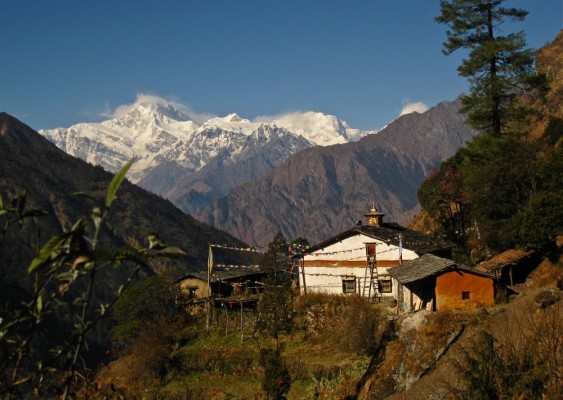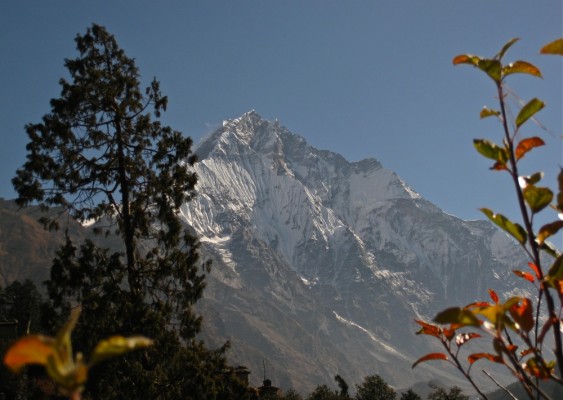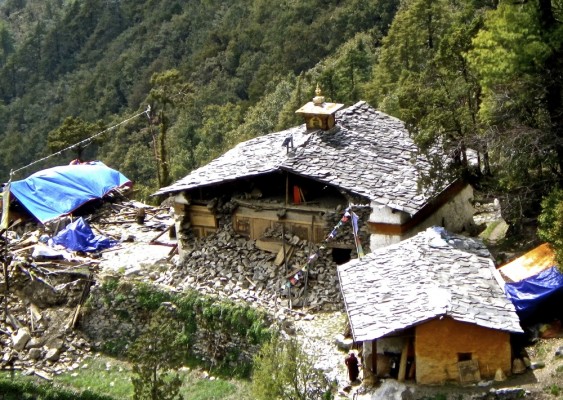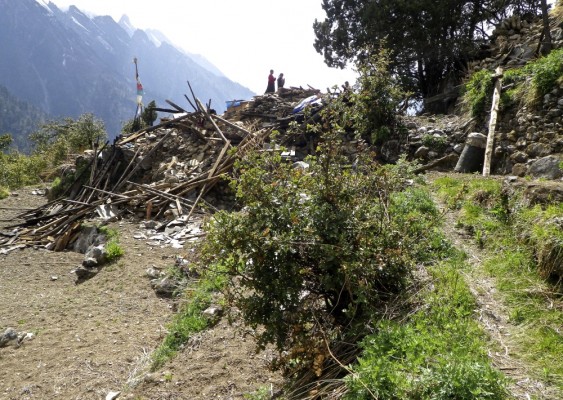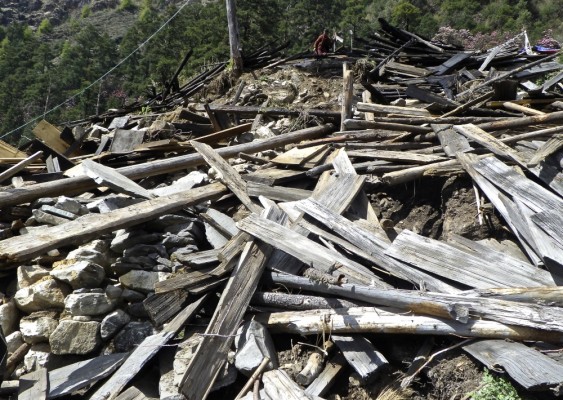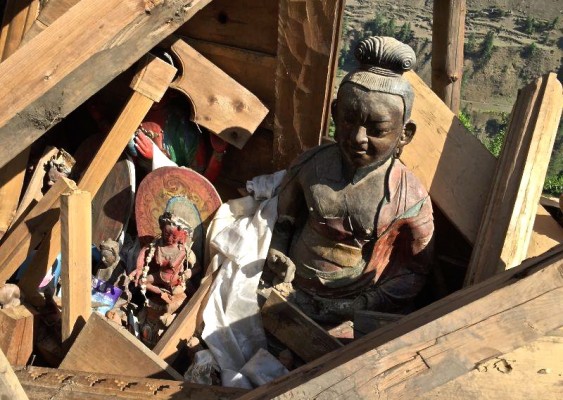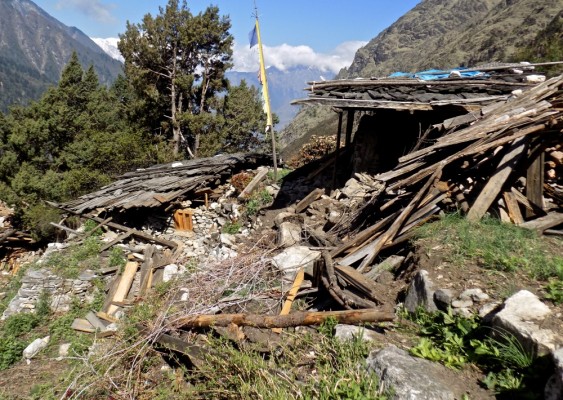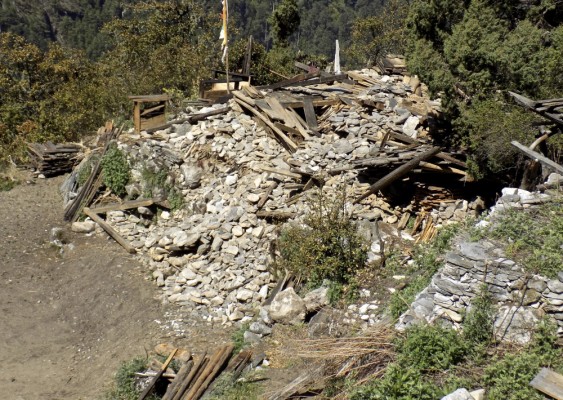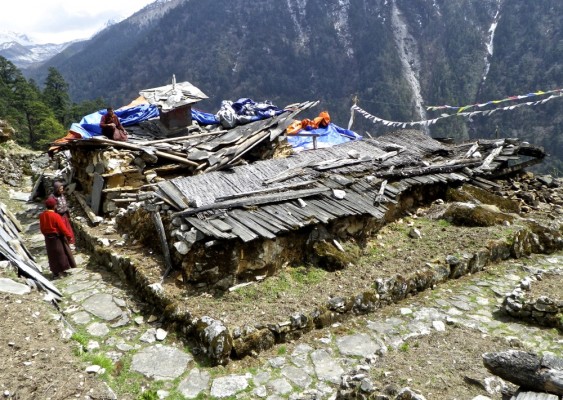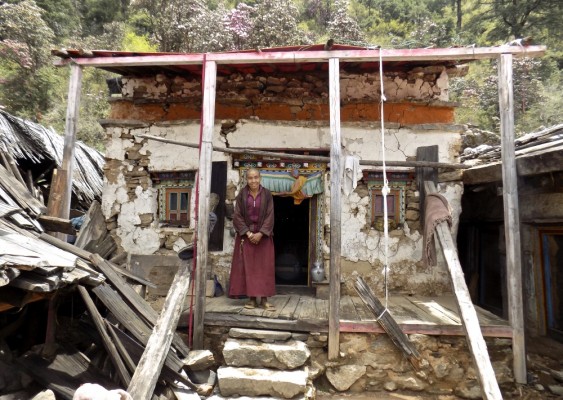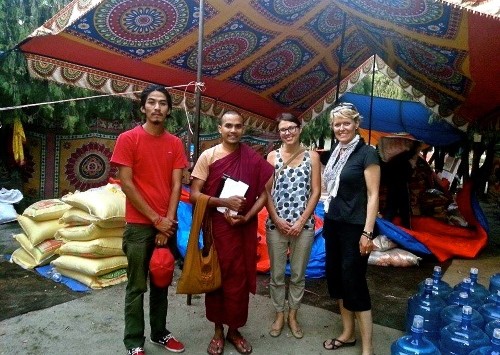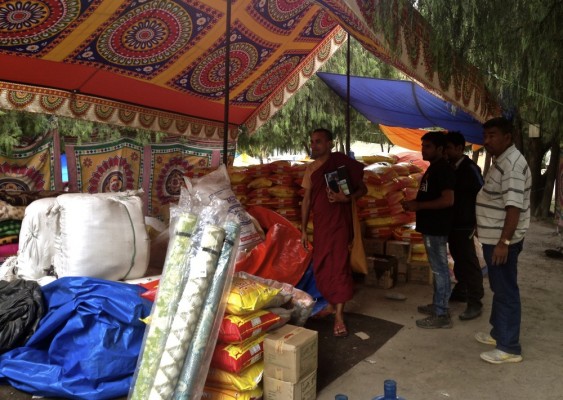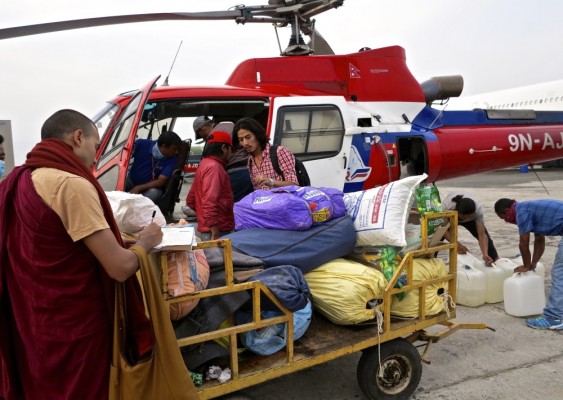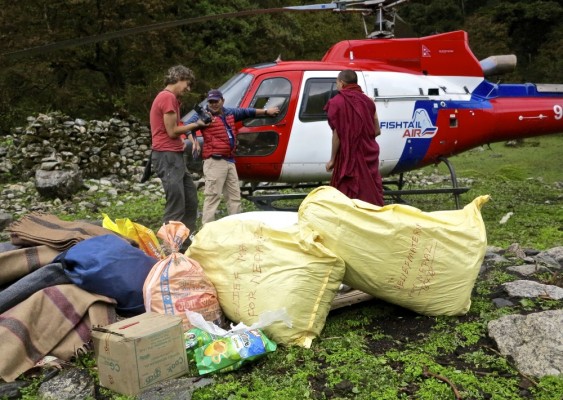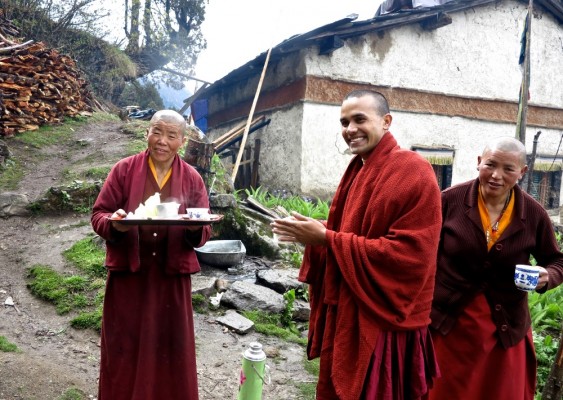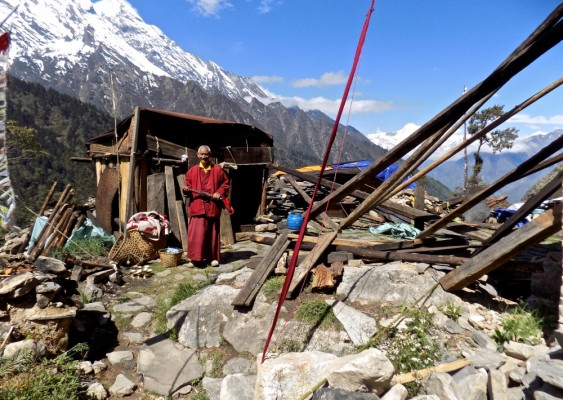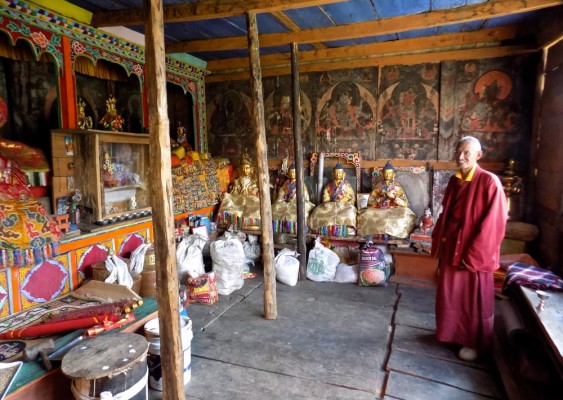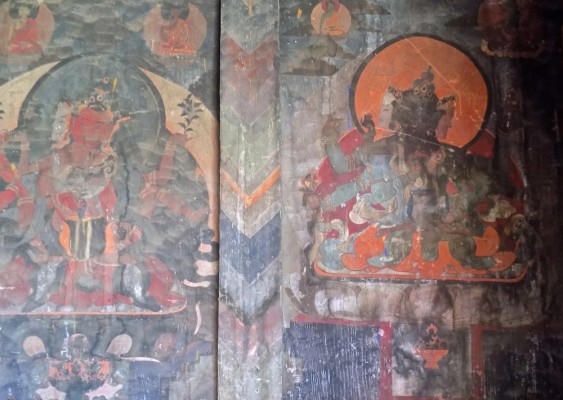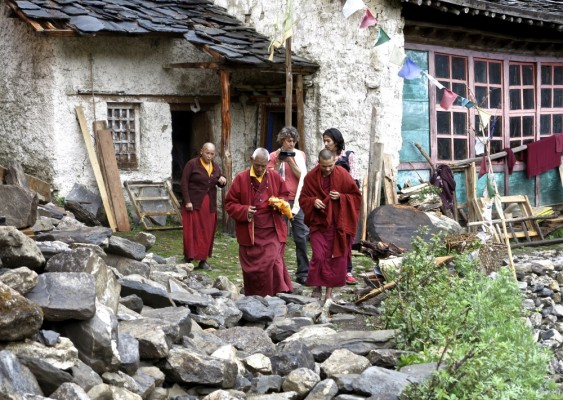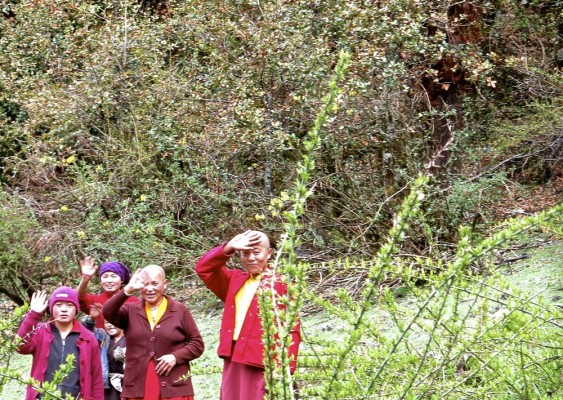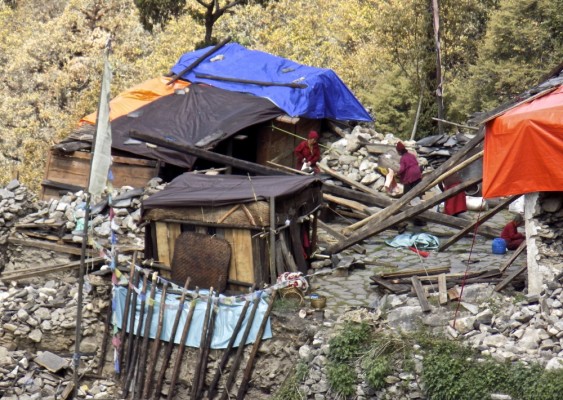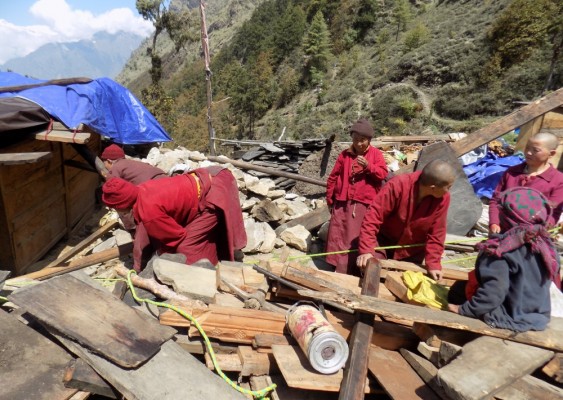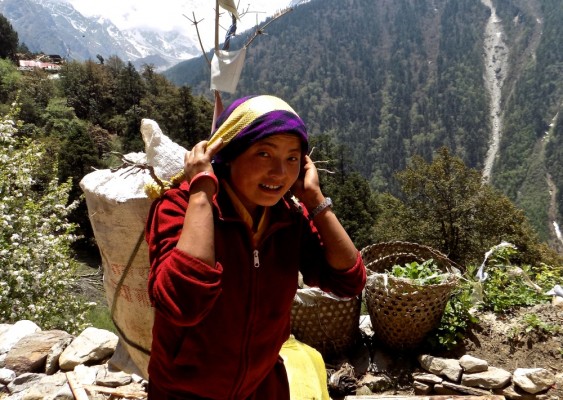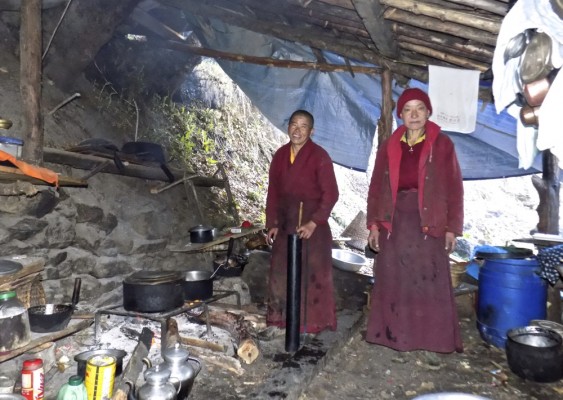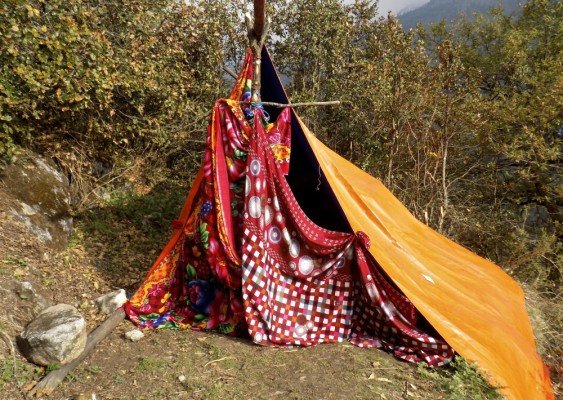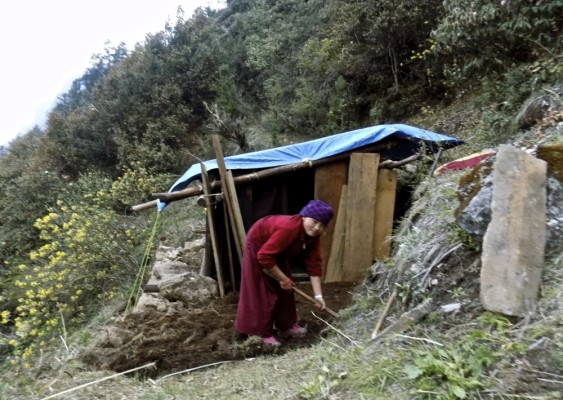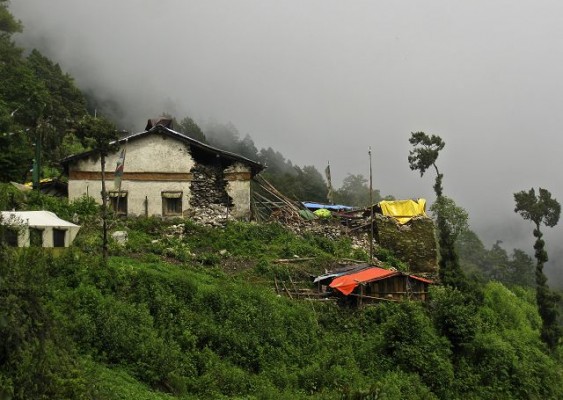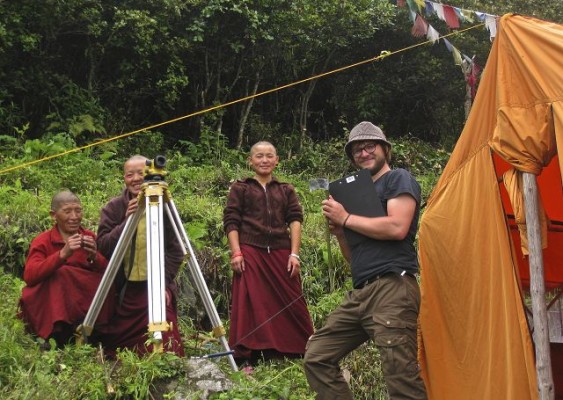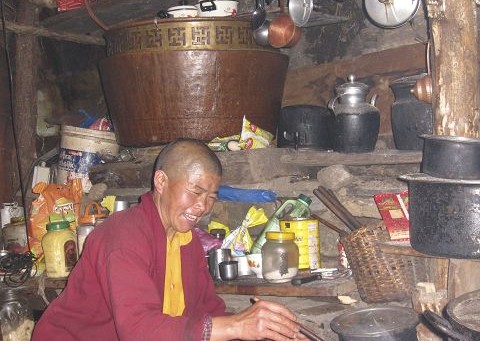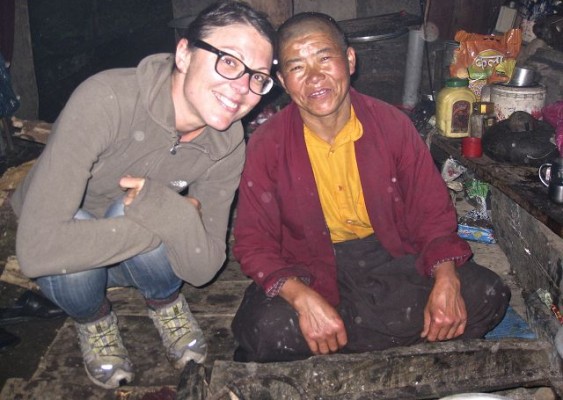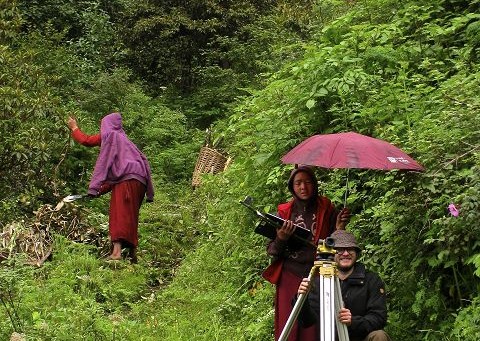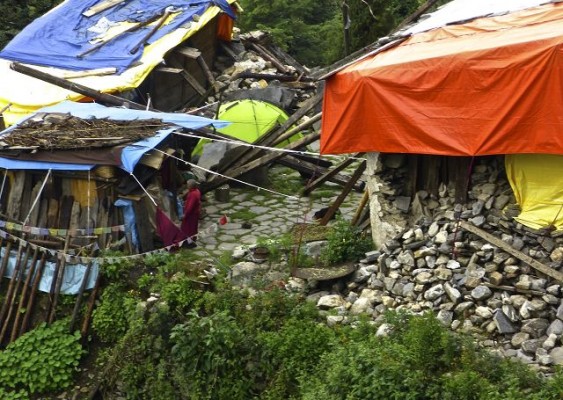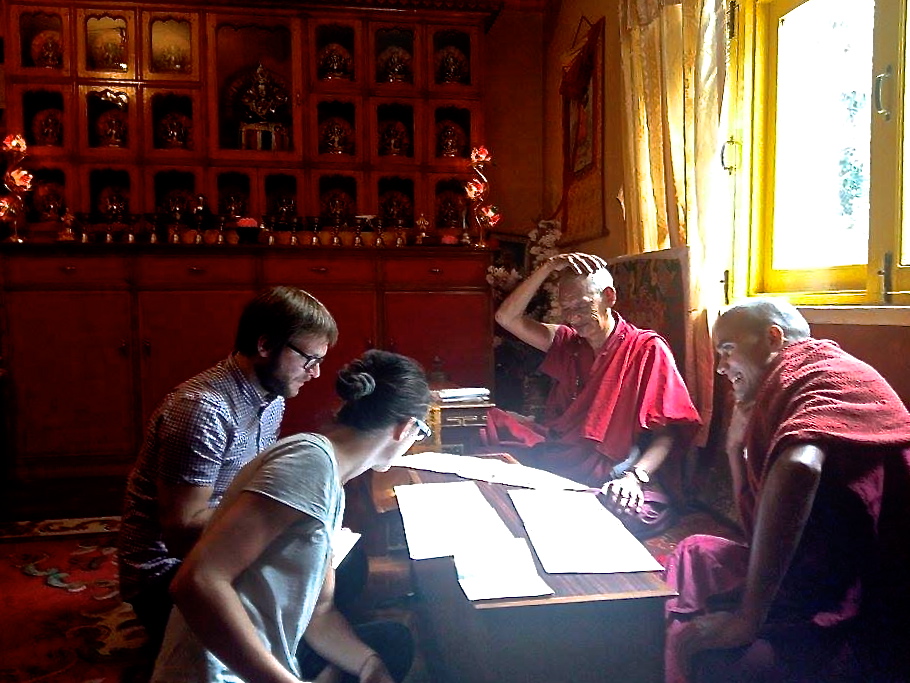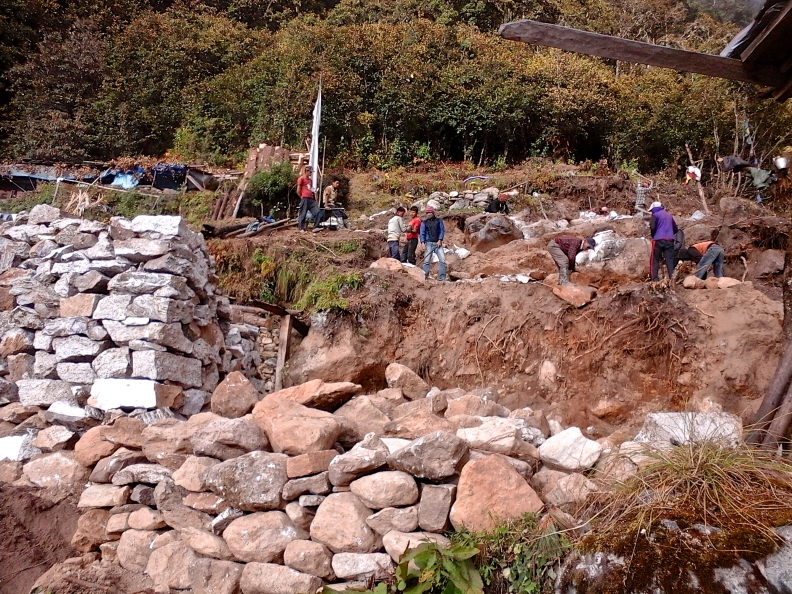Patron: Nadine Plachta
The setting
Tsum is a long drawn out valley situated in the northern highlands of the Gorkha District. Geographically speaking, it is divided between a lower section and an upper valley that are naturally separated by a steep ascent. Tsum is connected to the Nepalese lowlands towards the south but protrudes into Kyirong County of China’s Tibetan Autonomous Region in the north and east. The region is populated by the Tsumpa, that is a community of roughly 2000 ethnic Tibetans, who subsist through a combination of agriculture, animal husbandry, and trans-Himalayan trade in villages ranging in altitude from 2240 to 3361 meters. Their unique culture blends Buddhist and shamanistic religious practices, while their indigenous social institutions promote an egalitarian society and protection of the natural environment.
Tibetan sources indicate that people began migrating to Tsum from Tibet as early as the 11th century. Identified as part of a hidden land (sbas yul) in esoteric Tibetan literature, the valley was designated as place of refuge where Tibetan religion and culture could survive and thrive during times of social and political turmoil. By virtue of occupying a significant place in Tibetan sacred geography, Tsum has attracted pilgrims and renowned clerics for centuries. Importantly, its designation as a hidden land enticed such important lineages of married lamas (ngag pa) as the Nile Labrang to settle in the region. Continuous trans-Himalayan networks of religious exchange, most notably with the Buddhist masters, scholars, and authors residing at the famous site of Drakar Taso, eventually gave rise to a unique “borderland Buddhism”. Tsum can thus be regarded as a significant site of religious innovation in the transmission of Buddhist culture on the frontier of Nepal and Tibet.
Since the early twentieth century, the Tsumpa have been following special sealing decrees (shag rgya) designed to protect wildlife and the environment against excessive human exploitation, regulations that continue to govern human-environmental interactions today. Buffered by their relatively isolated location, the members of the Tsum community have managed to keep intact many of their unique cultural practices and administrative systems.
However, Tsum is undergoing rapid changes accelerated by the forces of development and the massive outmigration of youths. Due to the pace and trajectory of contemporary events the valley faces a tremendous loss of cultural knowledge, a process that many locals—especially the elderly but also many educated youths—are keenly aware of but feel powerless to prevent. Tourism is about to bring new incentives to the valley but at the same time the construction of a road to connect Nepal’s powerful neighbors, India and China, is challenging the local population. As incompatible as these developments appear, they create an unprecedented friction.
The earthquake
Tsum is situated very close to the epicenter of the devastating earthquake that hit Nepal on April 25. The valley is thereby known to be among the most severely affected Himalayan regions. Many locals report that international assistance is still scarce. Whereas the twenty-two villages of lower and upper Tsum are in the focus of homegrown youth and grass root relief campaigns, no such efforts have reached the nunneries of the valley so far. The households, which have traditionally supported the nuns’ communities, are primarily struggling with their own traumatic experiences.
Gompa Lungtang is one such institution where relief support is overdue. Situated at the foot of the Ganesh Himal, it currently houses thirty nuns. The nunnery’s history dates back to 1259, when Mabdun Rachen (1209-1277), the founder of the little-known Dochen Kagyu tradition of Tibetan Buddhism, built a mountain hermitage at this important site.
A two hours walking distance of Gompa Lungtang is the tiny hamlet of Domje. Among the six households is a small health clinic affiliated with Gompa Lungtang, where a senior nun treats villagers with traditional Tibetan medicine. Attached to the clinic is a school where twelve young renunciates receive instructions by the elder.
At the nuns’ communities of Gompa Lungtang and Domje devastation is an understatement. The kitchen, storeroom, and retreat buildings at Gompa Lungtang are gone. The nuns’ quarters lost. Wooden beams prevent the prayer hall to collapse. Murals, scriptures, and statues—some of which are more than four hundred years old—are buried in the debris. The sight of the clinic at Domje is similarly disturbing. The young nuns and their teacher seek refuge at Gompa Lungtang, where they stay in temporarily constructed shelters. And the monsoon season is fast approaching.
The next motor road is a five days walk to the south. So far, the Tsumpa relied on porters and mules to bring materials to the valley. Landslides triggered through the earthquake and its numerous aftershocks, however, block the trails. The region can only be reached by helicopter at the moment.
Quick help is now in demand. The nuns are in dire need of tents, blankets, and food. Those are the most critical materials at this point. Your donation enables us to deliver those relief supplies to the nuns. Additional money raised will go to the long-term reconstruction work of Gompa Lungtang, including its health post and school in Domje.
Update 18/05
A big thank you to everyone who had contributed to the ‘Rebuilding Tsum’ project so far—your generous contributions have made a tremendous difference in the lives of the many nuns at Gompa Lungtang, including its clinic at Domje, who have been affected by the two earthquakes that have hit Nepal in the past few weeks.
On May 16, with the help of Venerable Metteyya Sakyaputta, a Theravada Buddhist monk from Lumbini, we were able to send the first helicopter to the community of nuns who have not received any help so far. In the helicopter that parted Kathmandu as early as 06:30 in the morning, were Venerable Mettayya, Tenzin Kunchok, our project coordinator on the ground, and Michael Kastenbaum, an independent filmmaker from New York, who kindly offered us the footage of his video for fundraising purposes.
Your support has meant getting rice, lentils, oil, salt, blankets, tents, and tarps to the nuns—all of them homeless and vulnerable now as their quarters collapsed. Despite the suffering and despair the nuns are surrounded with, our team was welcomed with butter tea, a sign of the long-standing tradition of hospitality in Himalayan culture. And Lama Sherab Tendar Rinpoche, the head of the nunnery, did not hesitate to explain to the newcomers the historical significance of the nunnery’s statues, scriptures, and murals, some of which are more than four hundred years old. Given the limited time of a helicopter, our team departed in direction of Kathmandu shortly after.
Having returned to the capital, Tenzin Kunchok described his experience as follows: “When we reached Gompa Lungtang, the nuns started to cry tears of joy and sorrow. Tears of joy because they were hoping for help for such a long time already, and eventually, we reached the site with both emotional and material aid. And tears of sorrow because they had lost their homes in the earthquakes and its aftershocks. It showed their despair in face of the approaching monsoon. But what struck me most in this critical situation is that the nuns didn’t say a word to ask for help before. Their sense of humility and gratitude touched all of us”.
Footage of Michael Kastenbaum, a filmmaker and actor based in New York
Update 28/05
Some days ago, we were given a USB Stick with recent photos of the Gompa Lungtang nuns’ community.
We are excited to see that after our first load of relief materials sent by helicopter, the nuns took action and used the tents and tarps delivered to protect the statues and scriptures from the debris. As shown in the photos below, they also worked hard to construct shelters for their own belongings.
Through our partners on the ground we got to know that recently occurred landslides along the Budhi Ghandaki River block the trail to all seven VDCs in the northern Gorkha District, making it impossible for porters and donkeys to reach the region. We also heard that a landslide between Gho and Chhekampar villages cuts off the lower and upper valley section in Tsum.
For the time being we therefore depend on helicopters to support the nuns at Gompa Lungtang. As a single helicopter can carry a maximum load of not more than 450 kg, we are well aware of the fact that we are still in the beginning to ensure the nuns’ health and safety throughout monsoon.
Besides this, we are working hard to figure out the necessary steps for the reconstruction process of the nuns’ buildings. We plan to set up a team of experts, active youth, and local community members in order to utilize local natural and human resources to rebuild sustainably and more earthquake-proof. We want to ensure an environmental friendly reconstruction, using solar energy in a place that has not been connected to a hydropower plant to generate electricity.
Let’s work together to safeguard the future of the Gompa Lungtang nuns who uphold a very rare and unique Tibetan Buddhist tradition at the border of Nepal and Tibet.
Update 31/07
Since May, we have been able to arrange eight helicopters flights with 400-450 kg of supplies each for the community of nuns at Gompa Lungtang. The area continues to be accessible by helicopter alone due to frequently occurring landslides that block the walking trails along the Budhi Gandaki River in the lowlands.
Thanks to the numerous helicopter flights to provide the nuns with daily essentials, we believe that our primary target of bringing the community safely through the rainy season has been successful. Yet the steps necessary for initiating the reconstruction process are still only slowly being taken. Recently Ezwo Engineering Consultants of Augsburg granted support for this project. Timo Plachta, an engineer specialized in energy-efficient building techniques, visited the site and, together with Nadine Plachta, carried out a detailed survey of Gompa Lungtang and its health clinic in Domje village, on the basis of which the reconstruction plans can be drawn up.
Timo and Nadine Plachta stayed for seven days in the Tsum. Given the absence of a local power supply, they rented a manual land measurement device prior to their departure in Kathmandu and took it to the remote Himalayan region by helicopter. The day they flew in, they spent several hours waiting at Tribhuvan Domestic Airport due to bad weather. Low-hanging rain clouds obstructed the view even for the more experienced pilots. It was only late in the afternoon that together with Lama Sherab Tendar Rinpoche, the head of the nuns’ community, they reached the health clinic at Domje village. Shortly after their arrival, the young nuns pitched tents for the visitors, who were dismayed at the sight of the heavily damaged building and the loss of the vast collection of herbal medicine the earthquake had caused. Ani Kunsang, the local doctor and caretaker of the place, introduced her guests to the complicated process of collecting and processing the medicinal plants: “It is not easy to collect the herbs used for Tibetan medicine. It requires a lot of training. For only when you know all the plants and the climate in the higher altitudes that enable them to grow can you go and search for them. After collection, it is a long process of drying and mixing the plants according to the sickness you want to heal. We had more than two hundred different globules in our clinic, and people from all over the lower valley came to us. Now I don’t know what to do.”
The next morning, Nadine and Timo Plachta measured a barren field which Lama Sherab Tendar Rinpoche had selected for the new clinic to be built on. Three nuns then helped to carry a portion of the helicopter’s supplies along the narrow walking trail to Gompa Lungtang. Midway through the daylong journey, the group caught a breathtaking view of the Ganesh Himal range. The gentle summer weather did not last long, however. The following days, the siblings continued to work in drizzling rain, supported by the nuns, who held umbrellas over them and brought pots of tea across the site to cheer them up, as all the while on the other side of the valley rock falls were constantly occurring.
Already on the first day it became apparent that the team had underestimated the damage. Every single house needed to be rebuilt from scratch. Furthermore, it turned out that the architectural work would also include the work of an urban planner. Historically, the nunnery’s buildings were scattered across the hillside. They included a main assembly hall, two smaller shrine halls, a kitchen, a storeroom, a retreat area, and the nuns’ quarters. Lama Sherab Tendar Rinpoche now took the earthquake as an impetus to redesign the site. He asked Timo Plachta to consider the natural path of the sun in the reconstruction plan in order to ensure energy-efficient results. A landslide that was triggered by the earthquake had washed the water source away, and thus another water supply needed to be found and pipes laid. The main assembly hall would have to be relocated, and in some places hill slopes leveled to allow for more stable buildings to be constructed.
Timo Plachta attempts to come up with a model of the site when he will return to Kathmandu in late September. Upon approval of the architectural sketches by Lama Sherab Tendar Rinpoche, workers will then start with the preparatory work of leveling the ground and working stones.
Update 24/10
From September 22 to October 2 Timo Plachta was in Kathmandu to present the reconstruction details and architectural sketches to Lama Sherab Tendar Rinpoche and Venerable Metteyya, a Theravada Buddhist monk from Lumbini who is helping with fundraising for this project. They all met at O Sal Choling, the monastery at Godavari near the southern rim of the Kathmandu Valley where Lama Sherab Tendar Rinpoche resides. Timo Plachta had prepared a hundred-page booklet—including a master plan, building designs, environmental strategy, and construction manual—which the team discussed in detail.
While in Kathmandu, Timo Plachta further met with Rick Ehlert and Kevin Hagen, two engineers from Engineers Without Borders (EWB), to raise unresolved issues in the structural design. Rick Ehlert had helped in the aftermath of the devastating earthquakes which hit Haiti in 2010 and New Zealand in 2011, and thus possessed great expertise in earthquake-resistant building techniques. In his remaining time, Timo Plachta weaved the outcome of the conversations into a revised version of his masterplan, which was then approved with much gratitude by Lama Sherab Tendar Rinpoche.
In early October, the trail along the Budhi Gandaki had been repaired to an extent that persons used to difficult mountainous terrain could walk along it to higher altitudes. Shortly after this news reached Kathmandu, Lama Sherab Tendar Rinpoche sent 18 workers from the Helambu region to Gompa Lungtang. Our initial plan to employ members of the Tsum community proved to be unsuccessful, as all residents of the valley who were asked to help refused, citing work to be done on their houses and in their fields, or in clearing walking trails. Skilled workers from Yolmo, however, gratefully accepted the offer. Many maintained that they would use the money earned during the two-month contract period for reconstructing their own properties.
For NRs. 1,000 a day, including food and travel costs, the workers started to level the ground of the areal where the main assembly hall was to be rebuilt. Lama Tashi, the younger brother of Lama Sherab Tendar Rinpoche, visited the construction site in mid-October. After returning to Kathmandu he reported: “The workers are progressing very fast. They not only crush stones for the reconstruction but also cut down trees and process the wood.” While sharing recent photos and video footage of the site, he added with a big smile: “All of a sudden, the earth revealed a stone so large that the workers had to work on it for ten days!”
Update 22/11
According to Tibetan astrology, a black year will start on December 23 during which traditionally no foundation for a monastic institution is laid. For this reason, Lama Sherab Tendar Rinpoche traveled to Tsum in November to conduct a “land-blessing ceremony.” This ritual involves a series of prayers that culminates in the burying of a vase filled with auspicious substances at the place where the new main assembly hall will be established. In that way, the land spirits are rendered content and will help in enabling the reconstruction to go forward without obstacle.
(Video: Land blessing ceremony)
Lama Sherab Tendar Rinpoche reported that given the rapidly dropping temperature in the mountains, the workers will soon return to their families in the Helambu region and start rebuilding their homes with the money they earned.
Taking advantage of the low-priced flight services offered by Mission Aviation Fellowship (MAF), which will be discontinued at the end of this year, we booked two additional helicopters with reconstruction material for Gompa Lungtang. They will depart Kathmandu on November 27 and 30. As there are not sufficient storage facilities at the nunnery, however, the cargo will be stored at Nile village until next spring, when the reconstruction will continue. In the face of the coming winter, Lama Sherab Tendar Rinpoche has requested the nuns to migrate to Godavari, where they will be offered accommodations at O Sal Choling Monastery.
Meanwhile in Germany, Timo Plachta met with Philip Müller and Melf Suttner, two Berlin based structural engineers specialized in loam and timber construction. For two days they were developing ideas to give the building manual of Gompa Lungtang Nunnery the finishing touches.
